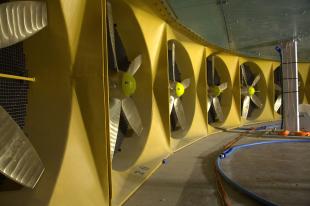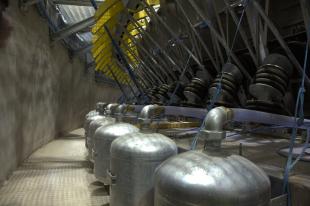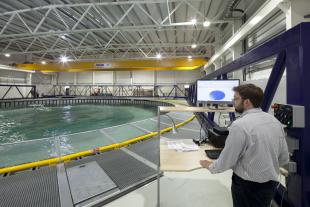The Tank
25m diameter and 2m depth, the tank’s function is to create waves and current for the tests being run at the facility. It works using 168 computer-controlled active absorbing wave maker paddles which independently push back and forth both disturbing the water to create waves and absorbing any incoming waves to prevent reflections. The current is driven by 28 Flow Drives beneath the floor which spin huge 1.7m impellers that drive water across the tank mimicking the ocean’s current. These operations allow the 2.4 million litres of water to simulate real ocean environments; which can be programmed to highly precise sea-states at the client’s digression.
Data and Measurement
The tank’s data acquisition system is uniquely advanced. Featuring a network of sensors which allow clients the data they need from their testing. This includes:
Cameras
4K HD colour video cameras, underwater cameras and the 6 degree of freedom Qualisys motion capture system based both on cameras both around the tank perimeter and underwater.
Water measurement
Sub millimetre accuracy 128Hz wave gauges for wave measurement, electromagnetic 2-axis flow meters for current measurement and a Vectrino acoustic Doppler current meter.
General measurement
The multi-channel, synchronised DAQ system for data acquisition, the 6 degree of freedom floor mounted load cell, several submersible inline tension/compression load cells and a selection of accelerometers and gyrometers.
Gantry
The Gantry is a platform sitting roughly 1m above the water's surface which can be moved to meet the needs of the test required. Any equipment, cables or tools required can be positioned here for easy access to the model and tank below. The gantry is used as the hub for data collection, with the wave gauges attached to it, it can be used to access the tank without the need for raising the tank floor.
Workshop
The workshop is the hub for constructing, modifying and repairing models, test equipment, mooring lines and test rigs for use in testing at the facility. It features a Stratasys F170 3D printer capable of making models and parts which are both intricate and strong for testing in the tank. The workshop also has a range of power tools and computer controlled (CNC) milling and turning for use in model making of a variety of material types. All of this is supported by a technical team including an experienced engineering machinist.
Model and material handling
Model handling is a hugely important part of FloWave’s operation. Vehicles can be backed up directly to a loading bay at the back of the the lab to unload models and materials. From there models can be handled both by forklift and the in-lab crane. The overhead crane has the ability to be positioned anywhere around the lab it can easily lift any models, tools or equipment into and out of the tank. The crane physically built the tank when the facility was under construction so has a weight limit of up to 5 ton, granting it huge range and reliability.






